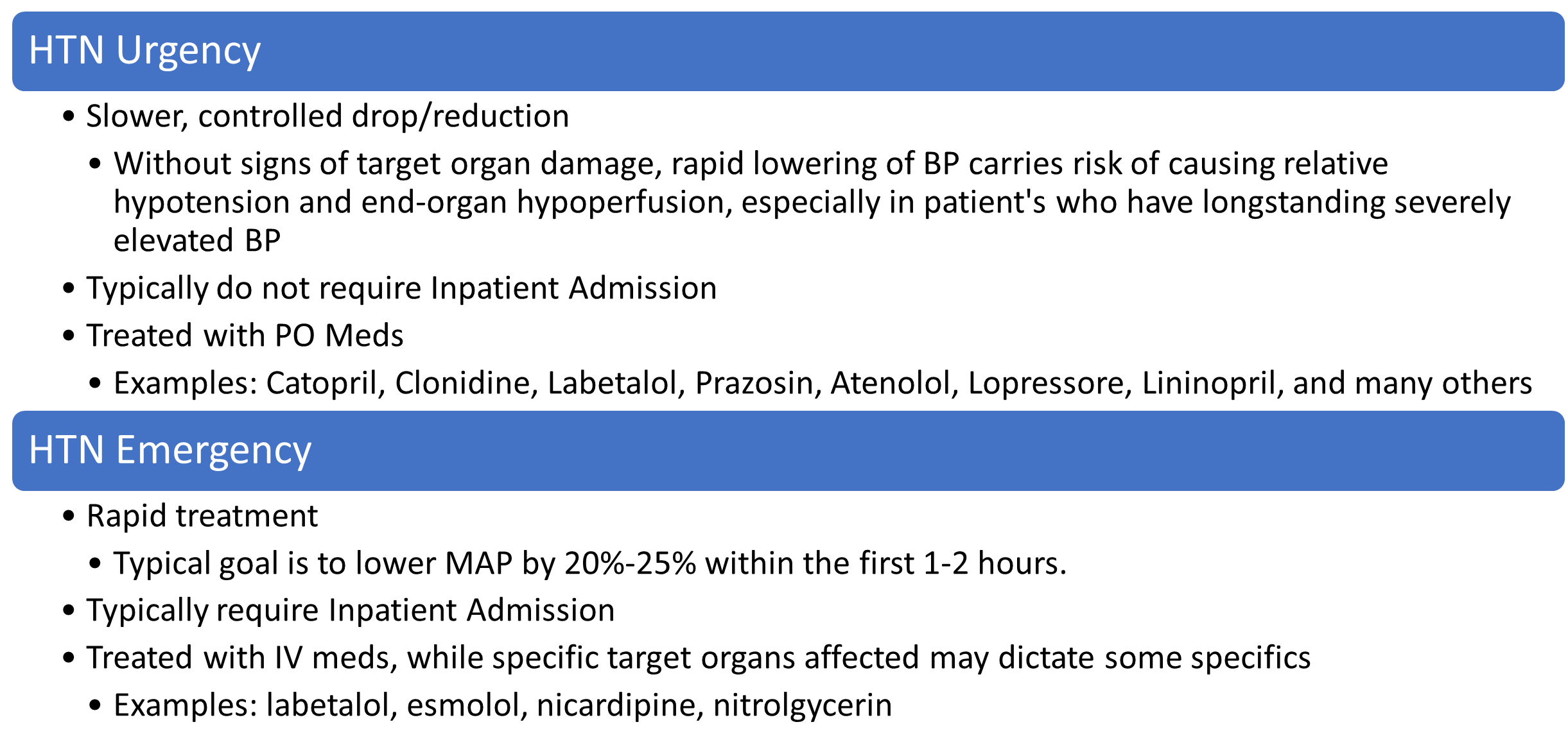Hypertensive Crisis
Definition:
- HTN: Systolic blood pressure (SBP) of 130mm Hg or more and/or diastolic blood pressure (DBP) of more than 80mm Hg
- HTN Crisis: Generic term to describe hypertensive urgency or hypertensive emergency, typically seen with elevated blood pressure readings of 180/120 or higher
- HTN Urgency: Elevated blood pressure, >180/120, without evidence of end organ damage
- HTN Emergency: Elevated blood pressure, >180/120, with evidence of end organ damage
- Resistant HTN: High blood pressure that does not respond to antihypertensive drugs
Diagnostic Criteria:
Key defining characteristic between HTN Urgency and HTN Emergency is the presence of end organ damage.
Examples of end-organ damage:
- CVA
- MI
- HTN Encephalopathy
- AKI
- Aortic Dissection
- Pulmonary Edema
Coding Considerations
Hypertensive Crisis, Emergency, and Urgency are classified as the code grouping I16 with the instructions to code also any identified hypertensive disease (I10-I15).
Review pertinent Coding Clinics related to HTN such as:
- AHA Coding Clinic, Fourth Quarter 2016, pg. 26 ICD-10-CM New/Revised Codes: Hypertensive Crisis, Urgency and Emergency
- AHA Coding Clinic, Fourth Quarter 2023, pg. 23-25: A new subcategory I1A, other hypertension, has been created with a new code to describe resistant hypertension (RH) (I1A.0). When assigning code I1A.0, the specific type of hypertension, such as essential or secondary hypertension is sequenced first.
CDI Best Practice Considerations
- Hypertensive Crisis (I16.9) and Hypertensive Emergency (I16.1) are both classified as CC’s, whereas Hypertensive Urgency (I16.0) is a non-CC.
- Providers often will document “malignant HTN” and “accelerated HTN,” thinking they have included the required specificity. However, these are outdated terms and index to Essential (primary) HTN (I10), a non-CC. Query for further specificity when diagnostic criteria are met.
- In HTN Emergency patients, ensure the diagnosis of the end-organ damage is documented and supported by clinical indicators in the record. Query for specificity/clarification as needed.
- Review documentation of HTN Urgency closely, querying when criteria is met to specify as HTN Emergency.
- Resistant HTN is not classified as a CC or MCC. Review the record thoroughly for clinical indicators and treatment to support querying for HTN Crisis/Urgency/Emergency when appropriate.
Differentiating between HTN Urgency & Emergency can also be see in treatment regimen:

Review the H&P closely for reported symptoms and physical exam findings. Note that physical exam findings will vary depending on target organ, but some common symptoms & findings to review for include:

Looking for CDI help?
Learn more about e4health CDI Solutions. Our Team is leading the way in the CDI industry.
e4health CDI Education
Need help to earn CEUs or education your team? Visit the IQ Education Center and get your free account or contact us for more information.
e4health is dedicated to elevating the business of healthcare. We are committed to offering support and the most current information and updates to collaborate with coding and CDI professionals to realize their fullest potential. We enthusiastically seek opportunities to develop ourselves and each other. We understand that knowledge is the key to success for our clients navigating the ever-changing health information management landscape.

Earn FREE ACDIS CEUs when you join Staci Josten, RN, BSN, CCDS, Alyson Swinehart, BSN, RN, CCDS, and other CDI leaders for a roundtable discussion regarding important, timely industry topics! The topic for January’s discussion is: CDI’s Impact on Risk Adjustment and Publicly Reported Data. We will provide background on this topic, share industry insights, and facilitate collaborative discussion with guided questions and answers.
Click here to register!
Learning Objectives:
- Define CDI’s impact on risk adjustment and publicly reported data.
- Describe risk adjustment methodology.
- Identify four main websites for publicly reported data.
What is the e4health CDI Leadership Roundtable?
The goal for the virtual CDI Leadership Roundtable Discussion is for CDI leaders to explore specific topics within CDI, learn about the topic and from each other. During each roundtable, e4health CDI Leader’s will present a CDI topic, spend time sharing current industry standards or some education regarding this topic and then open with probing questions for group discussion.
Who should attend the e4health CDI Leadership Roundtable?
The focus of this group is for those who have influence over CDI program process, policy, and education.
Why should I attend the e4health CDI Roundtable?
This will be a wonderful place to learn, share your wins and challenges and collaborate with other CDI leaders across the industry. Also, after completing a survey, free ACDIS CEUs will be earned.
The information and opinions presented here are based on the experience, training, and interpretation of e4health. Although the information has been researched and reviewed for accuracy, e4health does not accept any responsibility or liability regarding errors, omissions, misuse, or misinterpretation. This information is intended as a guide; it should not be considered a legal/consulting opinion or advice.